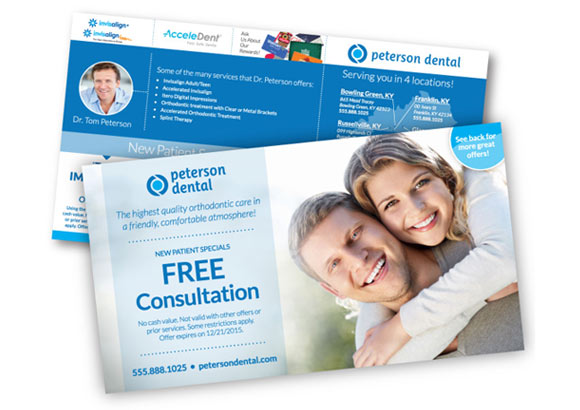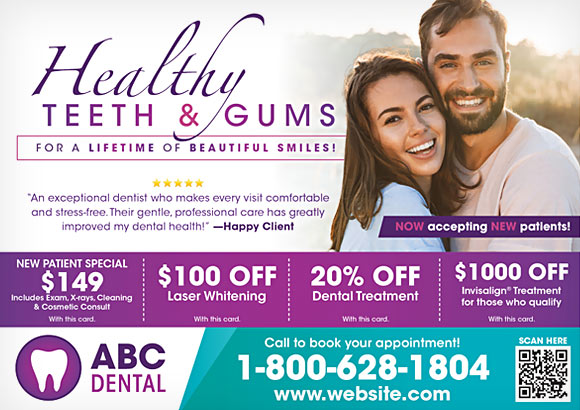Dental direct mail marketing reimagined.
Traditional direct is defined as advertising sent directly to prospective customers via the U.S. Postal Service.
To use a colloquialism, direct mail aint what it used to be.
Direct mail for dentists has undergone a resurgence in popularity and effectiveness, with 66% of respondents to the Vericast Consumer Intel Report* redeeming offers received in the mail. Another Vericast study also found that 72% of millennials routinely read direct mail ads. In addition to the potential value direct mail offers, its intrinsic value lies in its ability to actually put something in your audience’s hand, which, depending on the format and offer, possesses a shelf life, serving as an ongoing reminder to your prospective patient.
Digital and print technology have also made available cost-effective opportunities to customize print and fulfillment to even the smallest business. With the advent of I.P. address appending, hypertargeting, print-on-demand, personalization, and demographic customization, direct mail is now more than simply printing a postcard, affixing a postage stamp, and sending it to people in your service area.
A dental direct mail campaign is a tangible call to action, which goes directly into consumers’ homes. Direct mail also places you in touch with prospective patients whose privacy concerns might make them resistant to digital outreach (email, internet banner ads, Q.R. codes, etc.).
Success with direct mail entails several elements among which are: identification of objectives, setting a reasonable budget, performing benefit/cost and return on investment calculations, establishing your target audience(s), effective design of your mailer, efficient implementation, and establishing a complete and accurate tracking protocol.
The value of direct mail for your dental practice
To be sure, direct mail can help your dental practice grow by attracting new patients. By utilizing market segmentation technology, direct mail can also give you the power to change the composition of your patient base by, for example, targeting elderly individuals with the disposable income, need, and desire for big case dentistry, or attracting fee for service paying patients.

The seven steps to success with dental direct mail:
Your first step on the path to success with direct mail is to Identify Your Objectives. There are two general categories of objective that are appropriate for your dental practice. The first category is an increase the volume of new patients. For example, if your office is presently generating an average of 40 new patients per month and, based on your available capacity and other considerations, you could comfortably absorb an additional 20 per month, your objective would be to “Increase the number of new patients by an average of 50% per month.” The actual increase will probably vary from month to month: it is the average increase over time that is the relevant measure.

The second category of objective is a change in the composition of your patient base. For instance, you may want to change the patient mix from 60% fee-for-service and 40% insurance-based to 80% and 20%, respectively. Or, you may want to attract more patients desiring a specific procedure, such as cosmetic dentistry or dental implants. Whatever objective you choose, make it as specific as possible and commit it to writing.
Successfully connecting with your audience requires recognition and appreciation of the different ways prospective dental patients choose to interact with you and your various marketing messages. Baby Boomers tend to be more responsive to direct mail, while Millennials and other ‘digital natives’ are more responsive to electronic media.
Remember:
When you do not know where you are going,
any road will take you there.
1) Determine Your Budget
Once you have agreed on your objective, you’ll next want to come up with a budget for your direct mail campaign. One quick and dirty way to do this is to simply apply the following results-based rule of thumb: multiply your annual collections by: 2-3% to simply stem attrition, 5-7% for moderate growth, and 10-12% for aggressive growth. To calculate a budget based on your practice situation for a specific tactic under consideration (in this case, direct mail), you’ll want to estimate how many mailers are necessary to achieve your objective, then calculate your cost per mailer and multiply the two.

Let’s say you want to add 10 new patients per month to your practice. A reasonable expected response rate for a new patient mailing campaign is about .25% to .5%. Therefore, choosing the conservative response rate, you will need to send the number of mailers per month is 10/.0025 or 4,000. This assumes your team has the telephone communication skill set to convert 100% of new patient inquiries, which is optimistic even for the best-trained team. A more realistic figure is 80%. Accordingly, you may want to increase your mailing quantity as a function of the actual ‘conversion ratio’ that is, percentage of new patient inquiries your team is currently converting into kept appointments (what we call your Team Batting Average).
Let’s, therefore, assume for this example a mailing quantity of 5,000 (4,000/.80). You’ll then want calculate your cost per mailing. To do this, determine the cost of your mailing list, design, printing, fulfillment (letter shop), postage, and any tracking technology such as unique telephone numbers, website landing pages, etc., then divide by the anticipated mailing quantity. Depending on what, how, and how much you mail, your total cost per mailing can range anywhere from $.50 to well over $1.00. Let’s assume it is $.50. In this example then, your monthly budget is $2,500 (5,000 mailers times $.50).
2) Perform Your Benefit/Cost Calculations
Now that you are armed with your budget, you’ll next want to perform your benefit/cost and return on investment calculations. This is perhaps the most often overlooked step, which is unfortunate because this exercise can show you what you can reasonably expect by way of return on investment (ROI) from any tactic you may be considering, which provides you with greater control over your dental marketing plan, permitting you to tweak, expand, or eliminate a given tactic based on fact, not conjecture.

The exercise involves first determining the annual value to your practice of an average patient, then multiplying that value by your average patient lifetime to arrive at your practice’s average patient lifetime value. Armed with this, you next divide your Program Cost by your Patient Value, which yields your Breakeven Quantity (B.E.Q.). Any results that exceed your B.E.Q. means a profitable program.
3) Implementing Your Direct Mail Strategy
Now that you have a clear picture of your Objectives and Budget and have chosen to proceed with the program based on your benefit/cost analysis results, it’s time to choose who will receive your mailings and how often to send them (frequency).

4) Build Your Mailing List
If you’ve tried direct mail in the past and didn’t see the results you hoped for, there’s a good chance your mailing list was to blame.
Building your optimal mailing list entails identifying your target audience(s), then finding the best ways to secure as many mailing addresses for these people and families as possible. Utilize mailing data compilers to create a targeted list. Look for companies that focus on the healthcare space and are willing to provide you with sample records for review prior to committing to rental (lists are rented based on a certain number of mailings per order).
Some of the demographic variables available from data compilers include:
- Income
- Carrier and Rural Route
- Length of residence
- Renter, Homeowner, and Temporary Resident
- Single and Multi-Family Dwelling
- Marital status
- Expectant Moms
- Age of Resident(s)
- Presence of Children, including their Ages
- Wealth Index
- Demand for Dental Services
- Credit Rating
A relatively new development, which permits you to supplement your mailing list with visitors to your website, is sometimes called digital direct mail, whereby a visitor to your website can have their physical mailing address added to your mailing list. Just be sure your service provider does not inadvertently target retail establishments (for example, a prospective patient may be visiting your dental website from their local Starbucks, which means your mailing will go to the store instead of the prospective dental patient’s home), and that the distance the prospective patient is from your dental practice is not too great (for example, from out of state).
5) Segment and win
Your current and prospective patients are not, and should not be, considered as one monolithic mass. As shared above, individuals respond to different messages as a function of the group to which they belong, as well as where they are along their learning and motivation curve, so be sure your list contains people and families who represent a good fit for your practice e.g. residents living reasonably close to your office if you are a general dentist, families with children if you are a pediatric dentist and older individuals with a minimum level of household wealth for big case dentistry. Do not try to talk about family dental services to Generation Alphas* and, because Baby Boomers (those born between 1946 and 1964) are more responsive to direct mail, this group should comprise a significant component of your ‘marketing mix’ because this group has greater wealth and disposable income and is, therefore, more likely to want and need big case dentistry.
It is also important to recognize that the majority of people who receive your first mailing may not be ready to schedule a dental appointment. Various studies place the number of ‘touchpoints’ required to elicit a response at seven. Fortunately, the larger is your mailing list to qualified prospective patients, the more likely it is that you will present your message and offer to someone who is ready to respond upon receipt of the first, second, or third mailer.

The art and science of correctly segmenting your target audience can mean the difference between dental marketing success and failure.
6) Designing Your Direct Mail Piece
The next step in the process of implementing a successful direct mail strategy is to select your mailer design and content. This is perhaps the most important step, as what you send will, more than anything else, determine the quality and quantity of response to your mailer.
Search for individuals and households who, based on experience, are most likely to respond to the invitation being sent. Polling your current patients is a great way to learn what led to their decision to join your practice. Use these insights to inform your design and copywriting decisions.

Importance of custom direct mailer design
Use a professional designer who is experienced with color and graphic selection, as well as someone (rarely the designer) who is an expert at copywriting.
Elements of your successful dental direct mailer include a headline, offer, graphic, e.g., of happy individuals who match your target demographic, a simple map of your location, website, quick response (Q.R.) code, and easy-to-see contact information. The U.S. Postal Service has specific guidelines concerning acceptable design, so be sure you are working with someone who is thoroughly familiar with these guidelines, or you risk having your mailers rejected and never delivered!
Tips for creating an eye-catching mail piece
Designing a mailer that gets noticed and results in a response depends upon several factors, including the choice and use of color, images, and photographs; the degree of personalization; the mailer type (envelope, postcard, brochure, tear-off, magnet); the offer(s); and, of course, cost. In our experience, an oversized (6 inch x 11 inch) self-mailer has resulted in the highest response rate.
7) Direct mail program structure and implementation
Now that you have a clear picture of your Objectives and Budget and have chosen to proceed with the program and create your winning design, based on the results of your benefit/cost analysis, it’s time to structure your mailing campaign. This entails deciding how frequently to mail and at what time interval. As noted above, search for individuals and households that, based on experience, are most likely to respond to the invitation being sent. A good practice is to ensure the same person/household receives a mailer at least once a quarter i.e. 4 times per year. Again, that’s because a key success factor in direct mail (or any) marketing, is repeat exposure. As noted, the same person typically needs to receive several messages before being ready to respond. The other reality is that people within the same group will be along different stages of their learning and motivation curve. Some folks may just be ‘kicking the tires’ while others are ready to ‘pull the trigger.’
Effective and Ongoing Program Tracking and Evaluation
The final step to achieving a successful and repeatable direct mail campaign is effective and ongoing program tracking and evaluation. Use a telephone tracking number to monitor both the quantity and quality of calls generated by your mailing program. Doing so gives you all the information you will need to make informed decisions.

AIM’s Dental Marketing Dashboard (DMD) provides the means to ‘close the feedback loop,’ that is, to attribute a response to a given tactic or tactics. This means you know what tactic is working, and how well, which means no more flying blind when it comes to your dental marketing program.
Remember, a chain is only as strong as its weakest link. Be sure that every link in your direct mail service chain is solid!
*https://www.vericast.com/insights/blog/omnichannel-tactics-to-reach-all-of-your-audience/
**Generation Alpha is the name given to the generation of people who are or will be born between 2010 and 2024. Generation Alpha is the first generation to be born entirely in the 21st century. It comprises the largest cohort in human history, which will total over 2 billion people






























